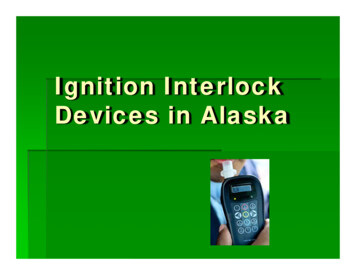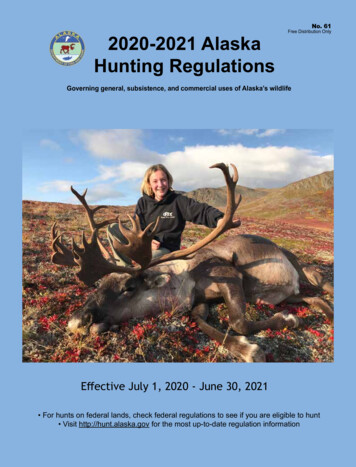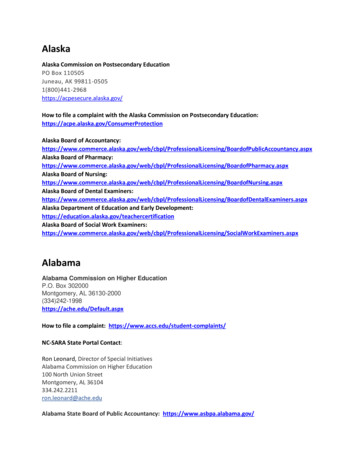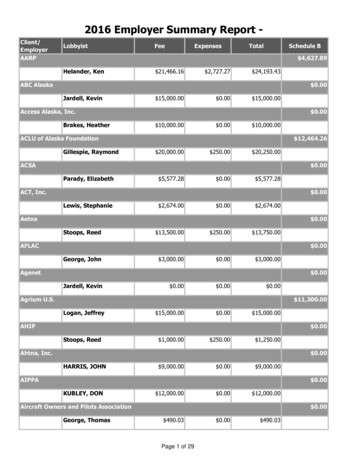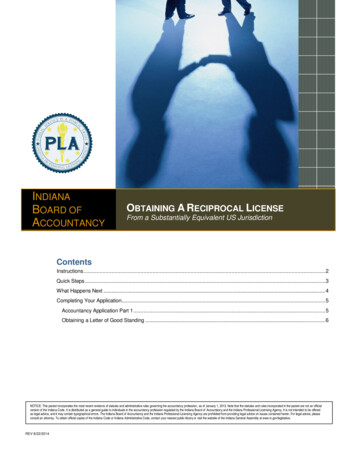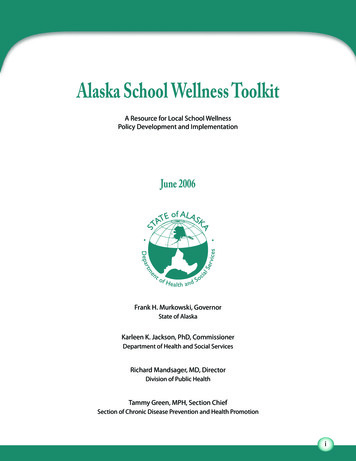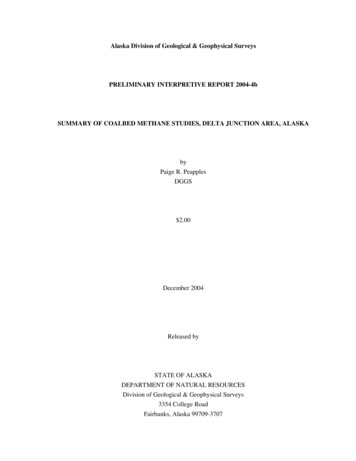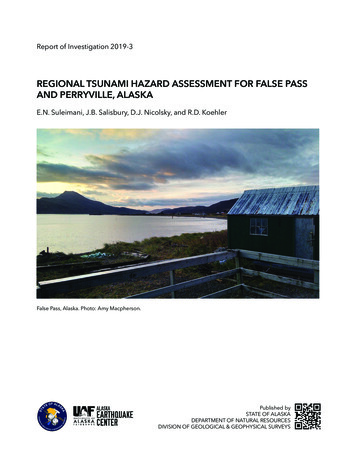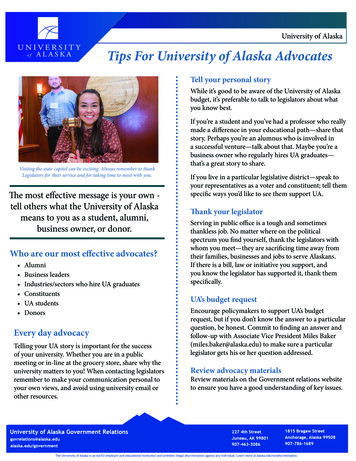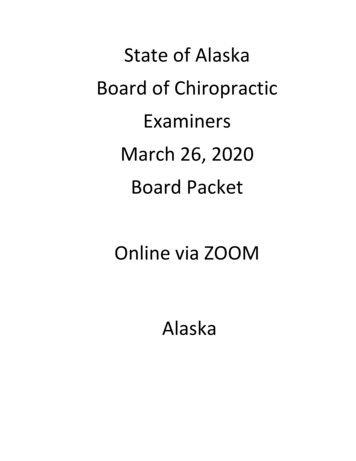
Transcription
State of AlaskaBoard of ChiropracticExaminersMarch 26, 2020Board PacketOnline via ZOOMAlaska
Roll Call
Alaska Board of Chiropractic ExaminersBoard Roster (As of 03/01/2020)Board MemberBrian Larson, m Expires03/01/2021Jonathan Vito, ChiropractorVice Chair03/01/201603/01/202003/01/2024James Morris, ChiropractorSecretary03/01/201703/01/2021John Lloyd, Chiropractor03/01/202003/01/2024Vacant
Meeting Name: Alaska Board of Chiropractic ExaminersMeeting Start Time: 10:00 AM AKDTMeeting Start Date: 03/26/2020Meeting End Time: 1:00 PM AKDTMeeting End Date: 03/26/2020Meeting Location: Teleconference Originating from ZOOM (online)Agenda:1. 10:00 a.m. - Call to Order/Roll Call2. 10:02 a.m. - Review/Approve Agenda3. 10:05 a.m. - Board BusinessA. Ethics Reporting4. 10:08 a.m. - New BusinessA. COVID-19i. Exams/Deadlinesii. Chiropractic as Essential Healthcareiii. Board Definitions for Urgent and Emergency Care Regarding Mandates5.1 and 9.1iv. Position Statement Regarding Telemedicine and AdvertisingB. ACS Questions/Requests5. 10:45 a.m. - Emergency Regulations ProjectA. Continuing Education Courses - In Person Credits for LiveWebinars/VideoconferencingB. Alaska Chiropractic Society Request - Extension for Certified ChiropracticClinical Assistant Deadlines6. 11:15 a.m. - Adjourn
Ethics Act Procedures for Boards & Commissions - Alaska Department of LawPage 1 of 7State of AlaskaDEPARTMENT OF LAWETHICS ACT PROCEDURES FOR BOARDS &COMMISSIONSAll board and commission members and staff should be familiar with the Executive Branch EthicsAct procedures outlined below.Who Is My Designated Ethics Supervisor (DES)?Every board or commission subject to the Ethics Act1 has several ethics supervisors designated bystatute. The chair serves as DES for board or commission members. The chair serves as DES for the executive director. The executive director serves as DES for the staff. The governor is the DES for a chair.2What Do I Have To Disclose?The Ethics Act requires members of boards and commissions to disclose: Any matter that is a potential conflict of interest with actions that the member may take whenserving on the board or commission. Any circumstance that may result in a violation of the Ethics Act. Any personal or financial interest (or that of an immediate family member) in a state grant,contract, lease or loan that is awarded or administered by the member's board or commission. The receipt of certain gifts.The executive director of the board or commission and its staff, as state employees, must alsodisclose: Compensated outside employment or services. Volunteer service, if any compensation, including travel and meals, is paid or there is a potentialconflict with state /EthicsBC.html3/14/2018
Ethics Act Procedures for Boards & Commissions - Alaska Department of LawPage 2 of 7 For more information regarding the types of matters that may result in violations of the EthicsAct, board or commission members should refer to the guide, “Ethics Information for Members ofBoards and Commissions.” The executive director and staff should refer to the guide, EthicsInformation for Public Employees.” Both guides and disclosure forms may be found on theDepartment of Law’s ethics website.How Do I Avoid Violations of the Ethics Act? Make timely disclosures! Follow required procedures! Provide all information necessary to a correct evaluation of the matter!3 When in doubt, disclose and seek advice! Follow the advice of your DES!What Are The Disclosure Procedures for Board andCommission Members?The procedural requirements for disclosures by members are set out in AS 39.52.220 and 9 AAC52.120. One goal of these provisions is to help members avoid violations of the Ethics Act. Theprocedures provide the opportunity for members to seek review of matters in advance of takingaction to ensure that actions taken will be consistent with the Act.Procedure for declaring actual or potential conflicts.Members must declare potential conflicts and other matters that may violate the Ethics Act onthe public record and in writing to the chair.Disclosure on the public record. Members must identify actual and potential conflicts orally at theboard or commission's public meeting in advance of participating in deliberations or taking anyofficial action on the matter. A member must always declare a conflict and may choose to refrain from voting, deliberations orother participation regarding a matter.4 If a member is uncertain whether participation would result in a violation of the Act, the membershould disclose the circumstances and seek a determination from the chair.Disclosure in writing at a public meeting. In addition to an oral disclosure at a board or commissionmeeting, members’ disclosures must be made in s/EthicsBC.html3/14/2018
Ethics Act Procedures for Boards & Commissions - Alaska Department of LawPage 3 of 7 If the meeting is recorded, a tape or transcript of the meeting is preserved and there is a methodfor identifying the declaration in the record, an oral disclosure may serve as the writtendisclosure. Alternatively, the member must note the disclosure on the Notice of Potential Violationdisclosure form and the chair must record the determination.Confidential disclosure in advance of public meeting. Potential conflicts may be partially addressedin advance of a board or commission's public meeting based on the published meeting agenda orother board or commission activity. A member identifying a conflict or potential conflict submits a Notice of Potential Violation to thechair, as DES, in advance of the public meeting. This written disclosure is considered confidential. The chair may seek advice from the Attorney General. The chair makes a written determination, also confidential, whether the disclosed matterrepresents a conflict that will result in a violation of the Ethics Act if the member participates inofficial action addressing the matter. 5 If so, the chair directs the member to refrain from participating in the matter that is the subject ofthe disclosure. An oral report of the notice of potential violation and the determination that the member mustrefrain from participating is put on the record at a public meeting.6Determinations at the public meeting. When a potential conflict is declared by a member for thepublic record, the following procedure must be followed: The chair states his or her determination regarding whether the member may participate. Any member may then object to the chair's determination. If an objection is made, the members present, excluding the member who made the disclosure,vote on the matter. Exception: A chair's determination that is made consistent with advice provided by the AttorneyGeneral may not be overruled. If the chair, or the members by majority vote, determines that a violation will exist if thedisclosing member continues to participate, the member must refrain from voting, deliberatingor participating in the matter.7If the chair identifies a potential conflict, the same procedures are followed. If possible, the chairshould forward a confidential written notice of potential violation to the Office of the Governorfor a determination in advance of the board or commission meeting. If the declaration is thicsBC.html3/14/2018
Ethics Act Procedures for Boards & Commissions - Alaska Department of LawPage 4 of 7made at the public meeting during which the matter will be addressed, the members present,except for the chair, vote on the matter. If a majority determines that a violation of the Ethics Actwill occur if the chair continues to participate, the chair shall refrain from voting, deliberating orparticipating in the matter. A written disclosure or copy of the public record regarding the oraldisclosure should be forwarded to the Office of the Governor for review by the chair's DES.Procedures for Other Member DisclosuresA member's interest in a state grant, contract, lease or loan and receipt of gifts are disclosed byfilling out the appropriate disclosure form and submitting the form to the chair for approval. Thedisclosure forms are found on the Department of Law's ethics website.What Are The Disclosure Procedures for ExecutiveDirectors and Staff?Ethics disclosures of the executive director or staff are made in writing to the appropriate DES(chair for the executive director and the executive director for staff). Disclosure forms are found on the ethics website, noted above.Notices of Potential Violations. Following receipt of a written notice of potential violation, the DESinvestigates, if necessary, and makes a written determination whether a violation of the Ethics Actcould exist or will occur. A DES may seek advice from the Attorney General. If feasible, the DESshall reassign duties to cure a potential violation or direct divestiture or removal by the employeeof the personal or financial interests giving rise to the potential violation. These disclosures are not required to be made part of the public record. A copy of a determination is provided to the employee. Both the notice and determination are confidential.Other Disclosures. The DES also reviews other ethics disclosures and either approves them ordetermines what action must be taken to avoid a violation of the Act. In addition to thedisclosures of certain gifts and interests in the listed state matters, state employees must discloseall outside employment or services for compensation. The DES must provide a copy of an approved disclosure or other determination the employee.How Are Third Party Reports of Potential Violations orComplaints s/EthicsBC.html3/14/2018
Ethics Act Procedures for Boards & Commissions - Alaska Department of LawPage 5 of 7Any person may report a potential violation of the Ethics Act by a board or commission memberor its staff to the appropriate DES or file a complaint alleging actual violations with the AttorneyGeneral. Notices of potential violations and complaints must be submitted in writing and under oath. Notices of potential violations are investigated by the appropriate DES who makes a writtendetermination whether a violation may exist.8 Complaints are addressed by the Attorney General under separate procedures outlined in theEthics Act. These matters are confidential, unless the subject waives confidentiality or the matter results ina public accusation.What Are The Procedures for Quarterly Reports?Designated ethics supervisors must submit copies of notices of potential violations received andthe corresponding determinations to the Attorney General for review by the state ethics attorneyas part of the quarterly report required by the Ethics Act. Reports are due in April, July, October and January for the preceding quarter. A sample report may be found on the Department of Law's ethics website. An executive director may file a quarterly report on behalf of the chair and combine it with his orher own report. If a board or commission does not meet during a quarter and there is no other reportableactivity, the DES advises the Department of Law Ethics Attorney by e-mail atethicsreporting@alaska.gov and no other report is required.If the state ethics attorney disagrees with a reported determination, the attorney will advise theDES of that finding. If the ethics attorney finds that there was a violation, the member whocommitted the violation is not liable if he or she fully disclosed all relevant facts reasonablynecessary to the ethics supervisor's or commission's determination and acted consistent with thedetermination.How Does A DES or Board or Commission Get EthicsAdvice?A DES or board or commission may make a written request to the Attorney General for anopinion regarding the application of the Ethics Act. In practice, the Attorney General, through thestate ethics attorney, also provides advice by phone or e-mail to designated ethics supervisors,especially when time constraints prevent the preparation of timely written cs/EthicsBC.html3/14/2018
Ethics Act Procedures for Boards & Commissions - Alaska Department of LawPage 6 of 7 A request for advice and the advisory opinion are confidential. The ethics attorney endeavors to provide prompt assistance, although that may not always bepossible. The DES must make his or her determination addressing the potential violation based on theopinion provided.It is the obligation of each board or commission member, as well as the staff, to ensure that thepublic's business is conducted in a manner that is consistent with the standards set out in theEthics Act. We hope this summary assists you in ensuring that your obligations are met.1The Act covers a board, commission, authority, or board of directors of a public or quasi-publiccorporation, established by statute in the executive branch of state government.2The governor has delegated the DES responsibility to Guy Bell, Administrative Director of theOffice of the Governor.3You may supplement the disclosure form with other written explanation as necessary. Yoursignature on a disclosure certifies that, to the best of your knowledge, the statements made aretrue, correct and complete. False statements are punishable.4In most, but not all, situations, refraining from participation ensures that a violation of the EthicsAct does not occur. Abstention does not cure a conflict with respect to a significant directpersonal or financial interest in a state grant, contract, lease or loan because the Ethics Actprohibition applies whether or not the public officer actually takes official action.5The chair must give a copy of the written determination to the disclosing member. There is adetermination form available on the Department of Law's ethics web page. The ethics supervisormay also write a separate memorandum.6In this manner, a member's detailed personal and financial information may be protected frompublic disclosure.7When a matter of particular sensitivity is raised and the ramifications of continuing without anadvisory opinion from the Attorney General may affect the validity of the board or commission'saction, the members should consider tabling the matter so that an opinion may be obtained.8The DES provides a copy of the notice to the employee who is the subject of the notice and mayseek input from the employee, his or her supervisor and others. The DES may seek advice fromthe Attorney General. A copy of the DES' written determination is provided to the subjectemployee and the complaining party. The DES submits a copy of both the notice and thedetermination to the Attorney General for review as part of the DES' quarterly report. If cs/EthicsBC.html3/14/2018
Ethics Act Procedures for Boards & Commissions - Alaska Department of LawPage 7 of 7the DES shall reassign duties to cure a potential violation or direct divestiture or removal by theemployee of the personal or financial interests giving rise to the potential violation.6/14The Attorney General and Department of Law staff may not provide legal advice to private citizens or organizations.Please contact an attorney if you need legal advice. The Alaska Lawyer Referral Service or your local bar associationmay be able to assist you in locating a lawyer.Alaska Department of Law1031 West 4th Avenue, Suite 200Anchorage, AK 99501attorney.general@alaska.govPhone: (907) 269-5100 Fax: (907) 276-3697TTY: 907-258-9161COPYRIGHT STATE OF ALASKA · DEPARTMENT OF LAW · EMAIL THE cs/EthicsBC.html3/14/2018
Ethics Disclosure FormCONFIDENTIALREQUEST FOR ETHICS DETERMINATIONTO:, Designated Ethics Supervisor(Identify Your Department, Agency, Public Corporation, Board, Commission)I request advice regarding the application of the Executive Branch Ethics Act (AS 39.52.010- .960) to my situation. The situation involves the following:I have provided additional information in the attached document(s).I believe the following provisions of the Ethics Act may apply to my situation:AS 39.52.120, Misuse of Official PositionAS 39.52.130, Improper GiftsAS 39.52.140, Improper Use or Disclosure of InformationAS 39.52.150, Improper Influence in State Grants, Contracts, Leases or LoansAS 39.52.160, Improper RepresentationAS 39.52.170, Outside Employment RestrictedAS 39.52.180, Restrictions on Employment after Leaving State ServiceAS 39.52.190, Aiding a Violation ProhibitedI understand that I should refrain from taking any official action relating to this matteruntil I receive your advice. If the circumstances I described above may result in a violation ofAS 39.52.110 - .190, I intend that this request serve as my disclosure of the matter in accordancewith AS 39.52.210 or AS 39.52.220.I certify to the best of my knowledge that my statement is true, correct, and complete. Inaddition to any other penalty or punishment that may apply, the submission of a false statementis punishable under AS 11.56.200 - AS 11.56.240.(Signature)(Date)(Printed Name)(Division, Board, Commission)(Position Title)(Location)Designated Ethics Supervisor: Provide a copy of your written determination to the employee advisingwhether action is necessary under AS 39.52.210 or AS 39.52.220, and send a copy of the determinationand disclosure to the attorney general with your quarterly report.Revised 2012
Ethics Disclosure FormReceipt of GiftTO:, Designated Ethics Supervisor,(Agency, Public Corporation, Board,Commission or Council)This disclosure reports receipt of a gift with value in excess of 150.00 by me or my immediate familymember, as required by AS 39.52.130(b) or (f).1.Is the gift connected to my position as a state officer, employee or member of a state board or commission?Yes2.NoCan I take or withhold official action that may affect the person or entity that gave me the gift?YesNo(If you answer “No” to both questions, you do not need to report this gift. If the answer to either question is “Yes,”or if you are not sure, you must complete this form and provide it to your designated ethics supervisor.)The gift isIdentify gift giver by full name, title, and organization or relationship, if any:Describe event or occasion when gift was received or other circumstance explaining the reason for the gift:My estimate of its value is The date of receipt wasThe gift was received by a member of my family. Who?If you checked “Yes” to question 2 above, explain the official action you may take that affects the giver (attachadditional page, if necessary):I certify to the best of my knowledge that my statement is true, correct, and complete. In addition to any otherpenalty or punishment that may apply, the submission of a false statement is punishable under AS 11.56.200 AS 11.56.240.(Signature)(Date)(Printed Name)(Division)(Position Title)(Location)Ethics Supervisor Determination:Designated Ethics Supervisor*ApproveDisapproved(Date)*Designated Ethics Supervisor: Provide a copy of the approval or disapproval to the employee. If action is necessaryunder AS 39.52.210 or AS 39.52.220, attach a determination stating the reasons and send a copy of the determinationand disclosure to the attorney general with your quarterly report.Revised 2012
From:To:Subject:Date:Bay, Thomas L (CED)Board Packet Info. - Chiro AdvertisingMonday, March 23, 2020 3:48:34 PMTomWe are going to have to be specific about not allowing Chiropractic advertising to be a direct"treatment" for COVID-19 while still protecting the ability to advertise the sciencesurrounding the benefits of immune function with relation to spinal adjustments. I've enclosedan article along with studies supporting this claim for our review during our upcomingmeeting.Chiropractic care is also ESSENTIAL HEALTHCARE when it comes to providingmusculoskeletal care to "frontline" providers and other crucial industry workers. Let's push formore than telemedicine privileges while increasing our efforts to create safe office polices.Thanks- Dr. James MorrisFrom Joe Borio, ChiroPassion Consulting.Why this is your BEST time to be getting your chiropractic adjustment. It's all aboutstrengthening your Immune System. Below are 109 published scientific studies demonstratinghow your chiropractic adjustment increases your immune function.1. Riley, G.W. Osteopathic Success in the Treatment of Influenza and Pneumonia.American Osteopathic Association – Chicago Session. July 1919. Journal of the AmericanOsteopathic Association, August 1919. 2. Riley, G.W. Osteopathic Success in the Treatment of Influenza and Pneumonia.American Osteopathic Association – Chicago Session. July 1919. Journal of the AmericanOsteopathic Association, August 1919. Special Reprint Journal of the American OsteopathicAssociation, Vol. 100. No. 5, May 2000. 3. Noll, DR., Shores, JH., Gamber, RG. Benefits of Osteopathic Manipulative Treatmentfor Hospitalized Elderly Patients with Pneumonia. Journal of the American OsteopathicAssocaition. Vol. 100. No. 12. December 2000. 4. Breithaupt, T., Harris, K., Ellis, J. Thoracic lymphatic pumping and the efficacy ofinfluenza vaccination in healthy young and elderly populations. Journal of the AmericanOsteopathic Association. Vol. 101. No. 1. January 2001. 5. Noll DR, Degenhardt BF, Stuart MK, Werden S, McGovern RJ, Johnson JC. Theeffect of osteopathic manipulative treatment on immune response to the influenza vaccine innursing homes residents: a pilot study. Altern Ther Health Med. 2004 Jul-Aug;10(4):74-6. 6. Degenhardt BF, Kuchera ML. Update on osteopathic medical concepts and thelymphatic system. J Am Osteopath Assoc. 1996 Feb;96(2):97-100. Allen TW. Coming fullcircle: osteopathic manipulative treatment and immunity. J Am Osteopath Assoc. 1998
Apr;98(4):204. 7. Schmidt IC. Osteopathic manipulative therapy as a primary factor in the managementof upper, middle, and pararespiratory infections. J Am Osteopath Assoc. 1982 Feb;81(6):3828. 8. Ward, EA. Influenza and Its Osteopathic Management. Eastern OsteopathicAssociation’s Seventeenth Annual Convention. New York, April 3, 1937. J. Am OsteopathAssoc. Sept. 1937. 9. Ward, EA. Influenza and Its Osteopathic Management. Eastern OsteopathicAssociation’s Seventeenth Annual Convention. New York, April 3, 1937. J. Am OsteopathAssoc. Sept. 1937. Special Reprint. J. Am Osteopath Assoc. Vol. 100. No. 5. May 2000. 10. Smith, KR. One hundred thousand cases of influenza with a death rate of onefortieth of that officially reported under conventional medical treatment. Annual Conventionof the American Association of Clinical Research, New York. Oct. 18, 1919. J. Am OsteopathAssoc. January, 1920. 11. Smith, KR. One hundred thousand cases of influenza with a death rate of onefortieth of that officially reported under conventional medical treatment. Annual Conventionof the American Association of Clinical Research, New York. Oct. 18, 1919. J. Am OsteopathAssoc. January, 1920. Special Reprints. J. Am Osteopath Assoc. Vol. 100. No. 5. May 2000. 12. Patterson, M. Osteopathic methods and the great flu pandemic of 1917-1918. JAOA(The Journal of the American Osteopathic Association) May 2000; 100(5):309-10 13. Masarsky, C. 1918. Dynamic Chiropractic. November 17, 2003, Volume 21, Issue 24http://www.chiroweb.com/archives/21/24/01.html 14. Kent, C. Chiropractic and infectious disease -- an historical perspective. TheChiropractic Journal April 2003/apr/apr2003kent.htm 15. Harte, D. Alternative to the sting of a failed flu vaccine. The Chiropractic Journal.March 2004. mar/harte.htm 16. Kent, C. Neuroimmunology and chiropractic. The Chiropractic Journal. October1995. oct/oct1995kent.htm 17. Lerche Davis, J. Flu Shot Scare Fuels Scams. WebMd 11/2/2004 http://dailynews.att.net/cgi- bin/health?e pub&dt 041102&cat women&st women103746&src webmd# 18. Lawrence, S. How to Dodge the Flu Without a Shot. Even without a flu shot, you canstill do something to protect yourself. WebMd. October 22, .htm 19. Whelan et al: The effects of chiropractic manipulation on salivary cortisol levels.JMPT. 2002 (25)3
20. Takeda et al: Long term remission and alleviation of symptoms in allergy andCrohn’s disease patients following spinal adjustment for reduction of vertebral subluxations.JVSR Vol 4. # 4. 2002 22. Selano, Grostic et al: The effects of specific upper cervical adjustments on the CD4counts of HIV positive patients. CRJ. Vol 3. # 1. 1994. 23. Brennan et al: Enhanced neutrophil respiratory burst as a biological marker formanipulation forces. JMPT Vol. 15 # 2 Feb. 1992. 25. Brennan PC, Kokjohn K, Kaltinger CJ, Lohr GE, Glendening C, Hondras MA, McGregorM, Triano JJ “Enhanced Phagocytic Cell Respiratory Burst Induced by Spinal Manipulation:Potential Role of Substance P” J Manipulative Physiol Ther 1991; 14(7): 399-407.26. Tuchin PJ “The Effect of Chiropractic Spinal Manipulative Therapy on SalivaryCortisol Levels.” Australian Journal of Chiropractic and Osteopathy 2: 1998; pp. 86-92. 27. Vora GS, Bates HA “The Effects of Spinal Manipulation on the Immune System (APreliminary Report)” The ACA Journal of Chiropractic 1980; 14: S103-105. 28. Masarsky CS, Weber M “Chiropractic and Lung Volumes - A Retrospective Study”ACA Journal of Chiropractic 1986; 20(9): 65-67. 29. Kessinger R “Changes in Pulmonary Function Associated with Upper CervicalSpecific Chiropractic Care” J Vertebral Subluxation Res. 1997;1(3): 43-49. 30. Menon M, Plaugher G, Jansen R, Dhami MSI, Sutowski J “Effect of Thoracic SpinalAdjustment on Peripheral Airway Function in Normal Subjects - A Pilot Study” ConferenceProceedings of the Chiropractic Centennial Foundation 1995; July 6-8: 244-245. 31. Masarsky CS, Weber M “Chiropractic and Lung Volumes - A Retrospective Study”ACA Journal of Chiropractic 1986; 20(9): 65-67. 32. Allen JM “The Effects of Chiropractic on the Immune System: A Review ofLiterature” Chiropractic Journal of Australia 1993; 23: 132-135. 33. Rhodes WR: "The Official History of Chiropractic in Texas." Texas ChiropracticAssociation. Austin, TX. 1978. 34. "Chiropractic Statistics." The Chiropractic Research and Review Service. BurtonShields Press. Indianapolis, IN. 1925.35. Wells BF, Janse J: "Chiropractic Practice. Volume 1. Infectious Diseases." NationalCollege of Chiropractic. Chicago, IL. 1942. 36. Kent C: "Neuroimmunology -- an update." The Chiropractic Journal. August, 2001/aug/aug2001kent.htm 37. Kent C: "The mental impulse-biochemical and immunologic aspects." TheChiropractic Journal. February, 1999/feb/feb1999kent.htm
38. Elenkov IJ, Wilder RL, Chrousos GP, Vizi ES: "The sympathetic nerve-anintegrative interface between the two supersystems: the brain and the immune system."Pharmacol Rev 2000;52:295-638. /595.pdf 39. Brennan PC, et al. Immunologic correlates of reduced spinal mobility.Proceedings of the 1991 International Conference on Spinal Manipulation(FCER):118. 40.Todres-Masarsky M, Masarsky CS. The Somatovisceral Interface: FurtherEvidence. In Masarsky CS, Todres-Masarsky M (editors). Somatovisceral Aspects ofChiropractic: An Evidence-Based Approach, 2001, Churchill Livingstone, New York.41. Korr IM: "Andrew Taylor Still memorial lecture: research and practice -- a centurylater." J Am Osteopath Assoc 1974 73:362.Murray DR, Irwin M, Reardon CA, et al:"Sympathetic and immune interactions during dynamic exercise. Mediation via a beta 2 adrenergic-dependent mechanism." Circulation 1992 86(1):203. 42. Felten DL, Felten SY, Bellinger DL, et al: "Noradrenergic sympathetic neuralinteractions with the immune system: structure and function." Immunol Rev 1987 100:225. 43. Felten DL, Felten SY, Bellinger DL, Madden KS: "Fundamental aspects of neuralimmune signaling." Psychother Psychosom 1993 60(1):46. 44.Kolata G: "Nerve cells tied to immune system." The New York Times May 13, 1993.45. Hosoi J, Murphy GF, Egan CL et al: "Regulation of Langerhans cell function bynerves containing calcination gene-related peptide." Nature 1993 363(6425):159. 46. Undem BJ: "Neural-immunologic interactions in asthma." Hosp Pract (Off Ed) 199429(2):59. 47. Sternberg EM, Chrousos GP, Wilder RL, Gold PW: "The stress response and theregulation of inflammatory disease." Ann Intern Med 1992 117(10):854. 48. Fricchoine GL, Stefano GB: "The stress response and autoimmunoregulation." AdvNeuroimmunol 1994 4(1):13. 49. Ottaway CA, Husband AJ: "Central nervous system influences on lymphocyte migration."Brain Behav Immun 1992 6(2):97.50. Weihe E, Krekel J: "The neuroimmune connection in human tonsils." Brain Behav Immun1991 5(1):41.51. Grossman Z, Heberman RB, Livnat S: "Neural modulation of immunity:conditioning phenomena and the adaptability of lymphoid cells." Int J Neurosci 1992 64(14):275. 52. Fidelibus, J.; An overview of neuroimmunomodulation and a possible correlationwith musculoskeletal system function JOURNAL OF MANIPULATIVE ANDPHYSIOLOGICAL THERAPEUTICS. 1989 Vol. 12 Pgs. 289-292
53. Davison, S.; Parkin-Smith, G.F.; The possible effect of cervical chiropracticmanipulation on short-term lymphocytic response - a pilot study WFC'S 7TH BIENNIALCONGRESS CONFERENCE PROCEEDINGS, MAY 1-3, 2003. 2003 Vol. 7th Edt. Pgs.278-80 54. Ali, S.; Hayek, R.; Holland, R.; Mckelvey, S.E.; Boyce, K.; EFFECT OFCHIROPRACTIC TREATMENT ON THE ENDOCRINE AND IMMUNE SYSTEM INASTHMATIC PATIENTS. PROCEEDINGS OF THE 2002 INTERNATIONALCO
Meeting Name: Alaska Board of Chiropractic Examiners . Meeting Start Time: 10:00 AM AKDT . Meeting Start Date: 03/26/2020 . Meeting End Time: 1:00 PM AKDT . Meeting End Date: 03/26/2020 . Meeting Location: Teleconference Originating from ZOOM (online) Agenda: 1. 10:00 a.m. - Call to Order/Roll Call 2. 10:02 a.m. - Review/Approve Agenda 3.
